The Serpent

Heavenly Vehicle. Seraphim. Guardian Angel.
 Of
all the symbols from ancient times it is the changeling serpent that
seems to
be connected to just about everything. Sometimes the healer
and
sometimes the daemon, sometimes masculine and sometimes feminine; the
serpent has been cast into many roles like a
good and evil twin emerging from one
schizophrenic personality. The serpent has appeared in
every
culture as a major player from the bestower of civilization to the
instigator of the fall of man. The following discussion will focus on
the
serpent as seraphim. The above illustration is based on one of the
Egyptian concepts of the serpent. It represents the
departed soul or the vehicle by which the soul is carried to Heaven.
This concept also relates directly to the winged solar disk
of Sumeria.
There are several Egyptian depictions of winged serpents. One is named
Wadjet for an Egyptian goddess. Another is a four winged serpent named
Chnuphis but this is the Iaculi winged serpent. "These
are creatures that are depicted usually on tombs of the departed in
Egypt. Many believe they are a symbol of those who are gone and that
they are some sort of watchers. Still others believe they are related
to Neheb-ka, which is a snake-headed goddess of the Egyptians."
(http://www.blackdrago.com/species.htm) As
stated before the serpent came to represent many
different things which includes an association with the soul. In doing
this research I prefer to keep to what the Sumerians have written but
the
Egyptians were influenced by many Mesopotamian concepts and I think
that it helps round out some of these ancient ideas from a
different cultural perspective. This includes
the winged solar disk which is one of the most recognizable symbols of
ancient Egypt. The popular belief is that the Egyptian symbol of the
winged solar disk predates the Sumerian winged disk. This is a good
example of putting the cart before the horse. The Sumerian symbol is
much more ancient and its memory extends back to the times of the
arrival of the
Caligastia 100 and could be besting the Egyptian representation by four
to five hundred thousand years. In both cases the idea of connecting
Heaven and serpent
is very ancient.
Of
all the symbols from ancient times it is the changeling serpent that
seems to
be connected to just about everything. Sometimes the healer
and
sometimes the daemon, sometimes masculine and sometimes feminine; the
serpent has been cast into many roles like a
good and evil twin emerging from one
schizophrenic personality. The serpent has appeared in
every
culture as a major player from the bestower of civilization to the
instigator of the fall of man. The following discussion will focus on
the
serpent as seraphim. The above illustration is based on one of the
Egyptian concepts of the serpent. It represents the
departed soul or the vehicle by which the soul is carried to Heaven.
This concept also relates directly to the winged solar disk
of Sumeria.
There are several Egyptian depictions of winged serpents. One is named
Wadjet for an Egyptian goddess. Another is a four winged serpent named
Chnuphis but this is the Iaculi winged serpent. "These
are creatures that are depicted usually on tombs of the departed in
Egypt. Many believe they are a symbol of those who are gone and that
they are some sort of watchers. Still others believe they are related
to Neheb-ka, which is a snake-headed goddess of the Egyptians."
(http://www.blackdrago.com/species.htm) As
stated before the serpent came to represent many
different things which includes an association with the soul. In doing
this research I prefer to keep to what the Sumerians have written but
the
Egyptians were influenced by many Mesopotamian concepts and I think
that it helps round out some of these ancient ideas from a
different cultural perspective. This includes
the winged solar disk which is one of the most recognizable symbols of
ancient Egypt. The popular belief is that the Egyptian symbol of the
winged solar disk predates the Sumerian winged disk. This is a good
example of putting the cart before the horse. The Sumerian symbol is
much more ancient and its memory extends back to the times of the
arrival of the
Caligastia 100 and could be besting the Egyptian representation by four
to five hundred thousand years. In both cases the idea of connecting
Heaven and serpent
is very ancient."Seraphim literally means "burning ones" in the Hebrew (Sarap, 'to burn')."
(http://www.answers.com/topic/seraph)
"The uniqueness of these "standing seraphim" in the OT and their obviously perplexing character have apparently led few scholars to concern themselves with their identification and significance. However, there is sufficient linguistic and archaeological evidence to suggest that the seraphim are to be identified as winged serpents and are Egyptian symbols of sacral and regal sovereignty."
(http://www.jstor.org/pss/3262795 Winged Serpents in Isaiah's Inaugural Vision by Karen Randolph Joines)
"Outside of the initial reference to the Seraphim in the Book of Isaiah Chapter 6, there are several more occurrences of the word saraph that are not used in direct reference to angels or celestial beings. Due to the fact that these occurrences of the word are used in varying contextual settings both literally and metaphorically, there are still some conflicting views on what type of angels were actually being described in those first introductory verses. The consensus is obviously split between the noun and verb saraph, with some scholars having concluded that the Seraphim are "fiery winged serpents", while others only attribute the verb to them, meaning they were not serpents, but merely "fiery beings" radiating intense light."
(http://www.seraphim.com/seraphim-in-judaism.html)
"The Winged Globe is pre-eminently a Rosicrucian symbol, although the Illuminati may lay claim to it, and it may be admitted that it is of Egyptian origin. The Winged Globe is the symbol of the perfected soul making its flight back to the source of its creation in the Elysian fields beyond."
(Swinburne, Clymer, The Rosicrucians Their Teachings (Quakertown, PA.: The Philosophical Pub. Co.), 1923 p. 112. Quoted by Springmeier, p. 115. http://www.seanet.com/~raines/disc.html)
"The older Babylonian concept of the seraphim is of serpents, as the name implies. Among many peoples of antiquity serpents played an important part in myth and folk-lore. For instance, there were (sic) Tiamat in the Babylonian legend of the Creation, and the Uræus serpent in Egypt."
(http://ha-nachash.blogspot.com/2009/02/seraphim-winged-serpents.html)
 "Agathos
Daimon
"Agathos
DaimonAlso known as Agathodemon, this creature can be found in the mythologies of Greece and Rome. Agathos in Greek meant "Good" and Daimon meant "Divinity"1, and this creature was much like a guardian angel. Regarded as the "Good Divinity", Agathos Daimon was the guardian of the household or personal home, and in other accounts this creature guarded a person, hovering around them invisibly2. For this protection, the people within the home would leave and reserve at least one glass of wine for this creature in thanks. Agathos Daimon is identified with Hermes3.
The Oracle of Trophonios, who resided in Lebadeia, could only be visited by people who followed strict rituals. These rituals involved Agathos Daimon. This is perhaps the Greek equivalent to the guardian angel, but in serpent form; they were depicted as winged serpents and in other forms as a giant snake.4"
(http://www.blackdrago.com/species.htm)
From the above quotes we can see that there is a long tradition (from Babylon but most certainly Sumeria and onwards) of the serpent being associated with the seraphim as protectors and carriers (guardian angels) of the soul. The Urantia Book has a number of things to say about the seraphim, death and the soul. The following quotes are but a fraction of what is on this subject in the Urantia Book:
Seraphim
"In the past ages on Urantia, these destiny guardians were about the only group of angels that had recognition. The planetary seraphim are indeed ministering spirits sent forth to do service for those who shall survive. These attending seraphim have functioned as the spiritual helpers of mortal man in all the great events of the past and the present. ...
Seraphim are the traditional angels of heaven; they are the ministering spirits who live so near you and do so much for you. They have ministered on Urantia since the earliest times of human intelligence." (Paper 113 Seraphic Guardians of Destiny p. 1241)
"Seraphim function as teachers of men by guiding the footsteps of the human personality into paths of new and progressive experiences. To accept the guidance of a seraphim rarely means attaining a life of ease. In following this leading you are sure to encounter, and if you have the courage, to traverse, the rugged hills of moral choosing and spiritual progress." (Paper 113 Seraphic Guardians of Destiny p. 1245)
"In the life of the flesh the intelligence of angels is not directly available to mortal men. They are not overlords or directors; they are simply guardians. The seraphim guard you; they do not seek directly to influence you; you must chart your own course, but these angels then act to make the best possible use of the course you have chosen." (Paper 113 Seraphic Guardians of Destiny p. 1246)
"Your conventional idea of angels has been derived in the following way:
During moments just prior to physical death a reflective phenomenon sometimes occurs in the human mind, and this dimming consciousness seems to visualize something of the form of the attending angel, and this is immediately translated into terms of the habitual concept of angels held in that individual's mind." (Paper 39 The Seraphic Hosts p. 438)
I have been told by a nurse who has worked in nursing homes and hospice that she has seen individuals while lying in bed alone reaching up with arms extended to something unseen. Very shortly thereafter that individual passes on. This is not an uncommon experience at all. In comforting the relatives of the deceased she would say, "We do not die alone." And this story was completely voluntary and on my part unexpected.
One last and maybe the most extraordinary quote (and I am sure unbelievable for some) is how wings became identified with angels. I must preface this first with Isaiah's (6:1–3) description of his vision of the seraphim:
"CHAPTER 6
KJV
In the year that king Uzziah died I saw also the Lord sitting upon a throne, high and lifted up, and his train filled the temple.
2 Above it stood the seraphim: each one had six wings; with twain he covered his face, and with twain he covered his feet, and with twain he did fly.
3 And one cried
unto another, and said, Holy, holy, holy, is the lord of
hosts: the whole earth is
full of his glory."In the year that king Uzziah died I saw also the Lord sitting upon a throne, high and lifted up, and his train filled the temple.
2 Above it stood the seraphim: each one had six wings; with twain he covered his face, and with twain he covered his feet, and with twain he did fly.
 Painting by Giotto titled: Stigmatization of St. Francis, Pisa altarpiece 13th century |
 Seraphim
- Petites Heures de Jean de Berry,
a 14th-century illuminated manuscript. |
In
the above painting by the Italian artist Giotto is the traditional
depiction of the seraphim. Two wings to cover the face, two wings to
cover the feet and two wings by which to fly. This is, of course,
directly based on Isaiah's description above. The illuminated
manuscript shows a pair of seraphim at the foot of the throne
and
seraphim usually work in pairs. Also the nimbus or halo is shown of
which one meaning is eternal life. While reviewing what the
Urantia Book had to say about these seraphim I was struck by these old
images of what we today would consider an unseen entity - the seraphim
- and what the Book has to say about this subject. The following is
that extraordinary quote:
...
And now, under the influence of the transformers and the transmitters, a strange metamorphosis begins as the seraphim is made ready to swing into the energy currents of the universe circuits. To outward appearance the seraphim grows pointed at both ends and becomes so enshrouded in a queer light of amber hue that very soon it is impossible to distinguish the enseraphimed personality."
(Paper 39 The Seraphic Hosts p. 438)
So the six winged seraphim as painted by Giotto and from the manuscript has two wings at the head, two wings down to the feet covering the body and the necessary two wings as the ancients believed to fly. These seraphim are also painted in a "fiery" red. In most representations of the seraphim here and elsewhere only the head is visible and therefore is not unlike the winged disk of Sumeria. Look closely at these angels and you will see all the elements that the Urantia Book uses to describe these transport seraphim: wings that cover the body from head to foot, pointed at both ends and "radiating intense light". And it was these experiences that gave birth to the descriptions of angels with wings, "a sharp pointed object" and winged fiery serpents.

The
first three images are from an earlier page and are repeated here for
comparison to the next two images of the seraphim and including as well
the two others above. The central hub in the popular opinion is
overwhelmingly considered a sun disk. I am not so sure. I always
thought it to be a
container of some sort but I am beginning to think about it differently
due to examining images of the six winged seraphim. If you look at
various images of this winged disk they have either the torus surround
and/or a central dot or hub with the disk itself.
This is not the sun. The ancients used descriptions that had a
celestial meaning such as shining, bright and burning. But they also
knew the difference between a star and a goddess named after a star by
using a determinative symbol. The hub is central to the images of
the winged disk. Now, the images from the medieval and Byzantine all
display the face of the seraphim. In the second to the last picture we
have a face surrounded by wings and no body. But they almost all have
the face in the center of the image with the nimbus.
The last image is from the Hagia Sophia and is one of four seraphim.
Notice the metal mask over the face which has been there for 160 years
and only in mid 2009 did restoration uncover the face beneath the mask.
This all leads back to the winged disk. The Sumerian, Babylonian,
Egyptian
and other winged disks are all seraphim. These later designs from the
middle ages for the
seraphim are based on Isaiah's
account and place the face in the center much like the more ancient
depictions of the seraphim. So the hub is not the sun but the "face" of
the celestial being or an abstract representation of the body itself.
Besides the later nimbus the early renderings of the seraphim as the
first
images show includes the folding panels of the wings and the triangular
pieces
which are not "rocket flare" but luminescence, the intense and burning
light
as described by the ancients. Phew.


From the
Stele of the Revealing in the Boulaq Museum in Cairo comes the
paraphrased translation by Aleister Crowley:
(http://tamesa.abrahadabra.net/%3Fpage_id%3D104)
(http://tamesa.abrahadabra.net/%3Fpage_id%3D104)
By Bes-na-Maut my breast I beat;
By wise Ta-Nech I weave my spell.
Show thy star-splendour, O Nuit!
Bid me within thine House to dwell,
O winged snake of light, Hadit!
Abide with me, Ra-Hoor-Khuit!
[Liber AL III:38]
(emphasis added)

Hadit as the winged disk
As a matter of record, I am no fan of Aleister Crowley. However his translation of the Stele is certainly interesting but does not follow what an Egyptologist has translated. Why Crowley was inspired to use the phrase "winged snake of light" may be due to his familiarity and deep understanding of Egyptian symbolism or it is poetic license. Still, why his translation differs as much as it does from others remains a question. Given the above statements of seraphim radiating light, he was closer to the truth than even he could have ever imagined.
Both translations in full can be found on the Tamesa Oasis web site.
My
First Theory on the Din.Gir and Solar Winged Disk
The following is
a crude but still evolving
concept of the logogram of the Din.Gir as reconstructed
After
researching the Tree of Life and the avenues it lead to, this modest
proposal is one culmination of that work. It is
predicated on several propositions. First and
most
important is all things on this page reflect something real. This
is what the solar winged
disk truly is. The solar
winged disk is a transport seraphim and was instrumental in
bringing celestials to the planet and taking souls back to a place we
call heaven. Even the Sumerians had a concept of the soul.
This
soul concept in all probability is Andite and stretches back into the
Paleolithic. The illustrations below are my first attempt to rectify
the image of the Din.Gir logogram with the winged disk. Not
quite there.

When the logogram for Din.Gir is rotated 90 degrees the resemblance to the obelisk becomes apparent. The pyramidion (capstone) in Egypt was encased in metal which would resemble a metal capsule. This capsule sits atop a column which has a base. It is the sacred stone set upon a pillar. The side view of the Din.Gir resembles the obelisk. The front view shows the panels extending outward much like the logogram. Here the panels are hinged to a torus shaped structure. The top view is a straight down view and the circle with the center dot is the Egyptian symbol for the sun. This symbol of the dot within a circle is older than the Egyptian culture and can be found in the earliest petroglyphs. By combining the views of the Din.Gir and the solar winged disk a rather modern looking vehicle is the result. This shape is a result of what the ancients depicted. Its form comes from the legends of the Paleolithic. The solar winged disk is ancient which is probably why there are differing ideas as to how exactly it looked. Over time there was some modification to the image. But considering its age, renderings of the solar winged disk are fairly consistent.
My
Second Theory on the Seraphim as the Solar Winged Disk
A second but
still evolving
concept of the seraphim as reconstructed
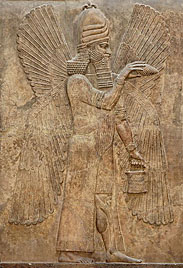


There
are at least two attributes of the seraphim as described by the
ancients. They are of the serpent and bird. The bird part is easy as it
is represented by wings. But serpent is much more obscure. The ancients
had a conception that something about the seraphim is serpentine. The
post Isaiah concepts of seraphim do not address the ancient
concepts of seraphim as serpent. There is nothing snake-like in the six
winged renderings of medieval Europe. What Isaiah describes is quite
human looking with the seraphim having hands, feet and a face. The
Urantia Book supports this as well as far as the body is concerned.
Since the body is not snake-like the only thing left are the "wings",
the shields, that must be snake-like in some aspect. I think it is the
unfolding of the "wings" during extension and contraction that gave
rise to the impression of serpentine movement coupled with the body
emerging from this second skin much like a snake shedding its old outer
skin. This rippling effect must have been quite pronounced and
mesmerizing to the ancients. The shields
encase the seraphim from head to foot and therefore must be pod like in
appearance. The third illustration shows how the pods could look before
closing. In this configuration they would resemble wings. The ancients
considered these protective shields as wings when observing
them. The idea of wings in this context was considered divine and this
concept was applied to all things considered divine both mortal and
immortal.
If you look at the first winged disk below you can see that the panels do not extend straight out but bend and curve. When this symbol became that of the sun god Utu/Shamash the panels had even more of a wave to them which supports I think that it is the appearance of these panels that the ancients considered serpentine.
If you look at the first winged disk below you can see that the panels do not extend straight out but bend and curve. When this symbol became that of the sun god Utu/Shamash the panels had even more of a wave to them which supports I think that it is the appearance of these panels that the ancients considered serpentine.
So,
here is the source for the deity bird and the serpent - one source with
two descriptions - and therefore the reason why the serpent and the
bird are the same thing, a seraphim. The irony in all this is that
seraphim do not have wings nor are serpentine. The Egyptian concept of
the winged serpent shows just how closely they were influenced by the
legends of Sumeria and how true they were to the original concept of
seraphim as having wings, being serpentine and associated
with
the soul. This also addresses the curious belief that the gods traveled
the sky by the use of a vehicle
(as discussed on page Din.Gir).
And this brings us back to the Anunnaki, the gods who did in fact
travel through the sky by such a vehicle.
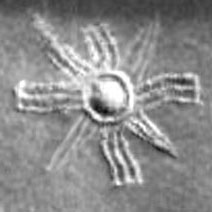

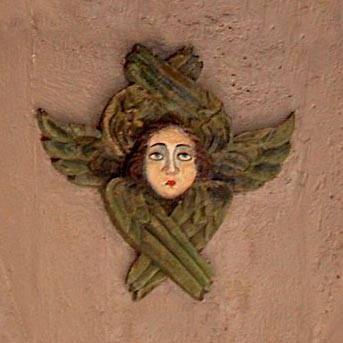

Myth or Reality?
"Somewhere between Heaven and Hell
A soul knows where its been.
I want to feel my spirit lifted up
And catch my breath again."
Crosby and Nash Lay Me Down
My
Third and Final Theory on the Seraphim as the Winged Disk
A final
concept of the
Serpent and the Bird as the icon of the
Seraphim
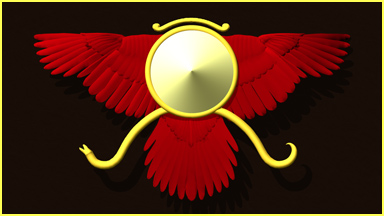
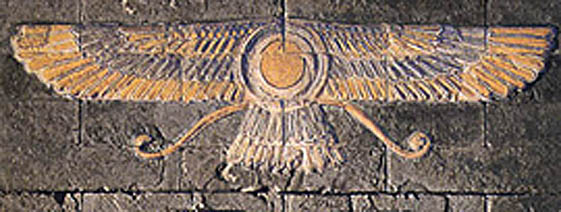



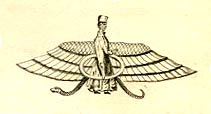

Time to Pull It All Together
 The
first is the Din.Gir where we can see left to right: luminescence,
cylinder shape, wings and apart from the descriptive elements: the
seraphim,
the Gir, that sharp pointed object (which it does become). Very
abstract but most of the main pieces are there. At some point the
Sumerian descriptive elements do fall away leaving the seraphim to its
own and becomes much more human looking per Isaiah's description.
The
first is the Din.Gir where we can see left to right: luminescence,
cylinder shape, wings and apart from the descriptive elements: the
seraphim,
the Gir, that sharp pointed object (which it does become). Very
abstract but most of the main pieces are there. At some point the
Sumerian descriptive elements do fall away leaving the seraphim to its
own and becomes much more human looking per Isaiah's description.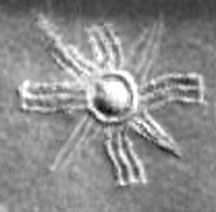 One
of the earliest icons has the four curving
"wings",
the luminescence,
the torus and the hub that is the seraphim. In some
cases the torus is much emphasized indicating it is something special
and is to be understood as part of the seraphim. The "wings" are curved
and connected to the torus
because the ancients are telling us that the "wings" are serpentine. It
is in the sky. This symbol became the icon of Utu/Shamash.
One
of the earliest icons has the four curving
"wings",
the luminescence,
the torus and the hub that is the seraphim. In some
cases the torus is much emphasized indicating it is something special
and is to be understood as part of the seraphim. The "wings" are curved
and connected to the torus
because the ancients are telling us that the "wings" are serpentine. It
is in the sky. This symbol became the icon of Utu/Shamash. The
Babylonian/Persian winged disk. This is the graphic that is the most
revealing of the bird and serpent. If you look closely at the serpent
you will see the head to the left and the curling of the tail to the
right. This icon has the outstretched bird, the serpent, the torus and
the
hub. This particular winged disk is from Susa in the land once
called Elam. It is also where the prophet Daniel lived for a
period of time at about 600 BC.
The
Babylonian/Persian winged disk. This is the graphic that is the most
revealing of the bird and serpent. If you look closely at the serpent
you will see the head to the left and the curling of the tail to the
right. This icon has the outstretched bird, the serpent, the torus and
the
hub. This particular winged disk is from Susa in the land once
called Elam. It is also where the prophet Daniel lived for a
period of time at about 600 BC.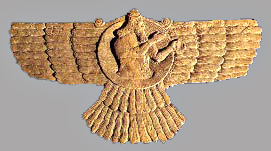 The
Assyrian winged disk. Resembles the Babylonian version except that
Ashur, the Assyrian national god, is shown within the hub itself. I do
not
think it is a simple combining of two differing elements. Putting the
god inside the hub has a deep religious purpose. This is the god in his
Boat of Heaven much like Inanna who also travels in her Boat of Heaven.
The
Assyrian winged disk. Resembles the Babylonian version except that
Ashur, the Assyrian national god, is shown within the hub itself. I do
not
think it is a simple combining of two differing elements. Putting the
god inside the hub has a deep religious purpose. This is the god in his
Boat of Heaven much like Inanna who also travels in her Boat of Heaven."Inanna gathered all the
me.
The me were placed in the
Boat of Heaven.
The Boat of Heaven, with
the holy me,
was pushed off from the quay."
From the Sumerian myth Inanna and the God of Wisdom
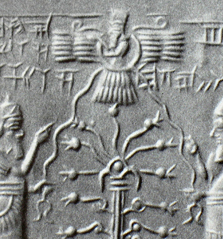

A second Assyrian winged disk floating above the Tree of Life. The serpent is very long and wavy, much more so than in most renderings. Notice that the serpent is grasped by the two attending genii. This same posture can be found in the Syrian reliefs most notably from Tell Halaf. I do not know, nor can I guess, at what this all means.
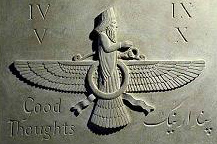 The
Faravahar from Persia and is the main holy symbol of Zoroastrianism. As
you can see the Assyrian and Persian "Boats of Heaven" are almost
identical. In this representation the serpent looks like a ribbon but
still keeps its wavy serpentine shape and a highly stylized open mouth.
In both of these images the
curved bar above the hub is evident. Other renditions of the Faravahar
have the serpent curled at
the ends rather than a ribbon which is closer to the Babylonian
representation.
The
Faravahar from Persia and is the main holy symbol of Zoroastrianism. As
you can see the Assyrian and Persian "Boats of Heaven" are almost
identical. In this representation the serpent looks like a ribbon but
still keeps its wavy serpentine shape and a highly stylized open mouth.
In both of these images the
curved bar above the hub is evident. Other renditions of the Faravahar
have the serpent curled at
the ends rather than a ribbon which is closer to the Babylonian
representation.
was pushed off from the quay."
From the Sumerian myth Inanna and the God of Wisdom


A second Assyrian winged disk floating above the Tree of Life. The serpent is very long and wavy, much more so than in most renderings. Notice that the serpent is grasped by the two attending genii. This same posture can be found in the Syrian reliefs most notably from Tell Halaf. I do not know, nor can I guess, at what this all means.
 The
Faravahar from Persia and is the main holy symbol of Zoroastrianism. As
you can see the Assyrian and Persian "Boats of Heaven" are almost
identical. In this representation the serpent looks like a ribbon but
still keeps its wavy serpentine shape and a highly stylized open mouth.
In both of these images the
curved bar above the hub is evident. Other renditions of the Faravahar
have the serpent curled at
the ends rather than a ribbon which is closer to the Babylonian
representation.
The
Faravahar from Persia and is the main holy symbol of Zoroastrianism. As
you can see the Assyrian and Persian "Boats of Heaven" are almost
identical. In this representation the serpent looks like a ribbon but
still keeps its wavy serpentine shape and a highly stylized open mouth.
In both of these images the
curved bar above the hub is evident. Other renditions of the Faravahar
have the serpent curled at
the ends rather than a ribbon which is closer to the Babylonian
representation. The
Egyptians had their own Boat of Heaven for their sun god Atum-Re. It
goes by various names such as the Solar Boat, Sun Boat, Solar Barque,
Solar Ship and such. Depending where he is in his trip across the sky
or in the underworld different symbols accompany him. The shape of the
boat to the left is the most common. In some instances mortal souls
also ride on his ship.
The
Egyptians had their own Boat of Heaven for their sun god Atum-Re. It
goes by various names such as the Solar Boat, Sun Boat, Solar Barque,
Solar Ship and such. Depending where he is in his trip across the sky
or in the underworld different symbols accompany him. The shape of the
boat to the left is the most common. In some instances mortal souls
also ride on his ship."The Egyptians believed that their sun-god Ra, traveling in his daily orbit, was actually the pilot of the "Boat of Heaven" which navigated the Celestial Sea. ... The Egyptians believed that they too would make this journey upon the Boat of Ra after their death, to be judged by Osiris in the underworld. In fact the priests of Egypt actually built a life-sized replica of this boat, which they would drag around the walls of the city in a daily ritual meant to imitate the revolutions of the Sun. This boat was actually discovered by archaeologists in 1954, buried next to the Great Pyramid at Giza." (http://quintessentialpublications.com/twyman/?page_id=22)
The above statement about a Celestial Sea is referring to the infinite cosmic ocean which is held back by the firmament. That is why the winged disk is the Boat of Heaven. It is the heavenly ship which sails across the firmament along with the moon, stars and planets. It is the ship of the gods but also the ship which ferries the souls of men and women to Heaven.
 If
there was any question about the Egyptian sun-god needing a Boat of
Heaven to travel upon the firmament then the illustration to the left
should remove all doubt. This rendering shows the sun-god about to rise
as the morning sun on his serpent ship. In the above picture the
sun-god is in a more familiar looking sun boat. Although these two
boats look quite different, they are the same thing - a Boat of Heaven
with this drawing representing the winged serpent in a more iconic way.
If
there was any question about the Egyptian sun-god needing a Boat of
Heaven to travel upon the firmament then the illustration to the left
should remove all doubt. This rendering shows the sun-god about to rise
as the morning sun on his serpent ship. In the above picture the
sun-god is in a more familiar looking sun boat. Although these two
boats look quite different, they are the same thing - a Boat of Heaven
with this drawing representing the winged serpent in a more iconic way.So far this discussion has focused on the winged serpent as seraphim and as the Boat of Heaven. Really being only differing aspects of the same thing these show mainly two wings which is the symbol of a bird in flight. But the ancients knew that the seraphim had four wing as depicted in the many four winged gods and genii. Later the Medieval paintings added the extra two wings to fly but this is probably a continuation of the concept from much more ancient ideas. In Persia Cyrus-as-seraphim had six wings. Other celestial figures from the same time period in Persia had four wings in the usual two up and two down position. All four winged gods, kings and celestials were shown the same way, two wings at the head and two wings for the body. We can put Cyrus on the time line at about 550 BC and his empire did include Palestine, Babylon, Anatolia, Egypt and more. Isaiah is located at about 700 BC.
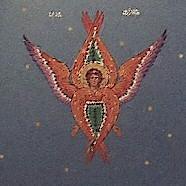 The
description by Isaiah includes the four wings which were used to
portray celestials and kings as divine plus the two needed to fly.
Apparently the other four wings were not used for flight but to protect
and to "cover the body" from head to foot. This is one of those obvious
things no one seems to mention. The placement of the face is
in the middle of the body (not being anatomically correct) echoes
the much more ancient understanding of how the seraphim should be
rendered. As you can see there are the four wings covering the body
(plus the two to fly), the red luminescence
and the face of the seraphim. If you were to rotate these four wings
covering the body into a horizontal position so that the top tips would
face you then the seraphim
would resemble the characteristic winged disk we are so familiar with.
The
description by Isaiah includes the four wings which were used to
portray celestials and kings as divine plus the two needed to fly.
Apparently the other four wings were not used for flight but to protect
and to "cover the body" from head to foot. This is one of those obvious
things no one seems to mention. The placement of the face is
in the middle of the body (not being anatomically correct) echoes
the much more ancient understanding of how the seraphim should be
rendered. As you can see there are the four wings covering the body
(plus the two to fly), the red luminescence
and the face of the seraphim. If you were to rotate these four wings
covering the body into a horizontal position so that the top tips would
face you then the seraphim
would resemble the characteristic winged disk we are so familiar with.Just as the Serpent and the Bird are forever linked to one another so is the winged disk, the seraphim, to the Tree of Life. Like the many stories in this website it all goes back to the Sumerians the last of the Andites. The stories of the gods, Van and the Lucifer Rebellion and Adam and Eve are woven into this ancient and cosmic story. Bits and pieces emerge within different cultures but the foundation legend is still there. As one example the Mayas did have a Tree of Life and associated with this tree was the Principal Deity Bird, Serpent Bird or also called the Celestial Bird that lived at the top of this sacred tree. It goes to show you how wrong archaeologists can be. The winged disk above the Tree of Life or as its Egyptian incarnation as the winged disk is not solar and certainly not associated with an eclipse. It is not even a solar winged disk. It is a seraphim, a religious symbol that has come from the Paleolithic memory, guarded and maintained by shaman and priest alike and perpetuated by legend, art and ritual for millenniums. It is only with the coming of the secular age that these ancient memories have been degraded by our professionals into folklore.
JRR
Tolkien
in the Lord of the Rings said it best:
"...and somethings that should have not been forgotton were lost.
History became legend, legend became myth..."
"...and somethings that should have not been forgotton were lost.
History became legend, legend became myth..."
The Soul, the Thought Adjuster and the Free Will Choice to Become Eternal
"In
ancient Egypt, Dr. Wegner noted, the human entity has separate
components. The body is important, and the elite went to great expense
to mummify and entomb it for eternity. In death, though, a life force
or spirit known as ka was immortal, and a soul known as ba, which was
linked to personal attributes, fled the body after death."
(http://tigrepelvar2.wordpress.com/2008/11/ By John Noble Wilford (NYT, November 18, 2008))
I find this statement - because it is such an ancient religious concept - even more compelling then the winged disk-as-seraphim. Readers who are familiar with the Urantia Book will see in this extremely old Egyptian belief a counter part to it within the Book. The Urantia Book also says that there are two parts which survive death. The ka which the Egyptians considered immortal is not unlike the Thought Adjuster, your spirit identity, which is pure spirit and immortal, a prepersonal fragment of God. The ba the Egyptian concept of the soul which "fled the body" is also what the Book says in that your soul does leave the body at death and is taken and this, your human identity, is guarded by the seraphim.
"The highest evidence of the reality and efficacy of religion consists in the fact of human experience; namely, that man, naturally fearful and suspicious, innately endowed with a strong instinct of self-preservation and craving survival after death, is willing fully to trust the deepest interests of his present and future to the keeping and direction of that power and person designated by his faith as God. That is the one central truth of all religion. As to what that power or person requires of man in return for this watchcare and final salvation, no two religions agree; in fact, they all more or less disagree." (Paper 102 The Foundations of Religious Faith p.1127)
"Modern man is confronted with the task of making more readjustments of human values in one generation than have ben made in two thousand years. And this all influences the social attitude toward religion, for religion is a way of living as well as a technique of thinking." (Paper 92 The Later Evolution of Religion p. 1013)
"Religious experience is the spiritual content of religion." (Paper 103 The Reality of Religious Experience p. 1140)
"It is literally true, 'Human things must be known in order to be loved, but divine things must be loved in order to be known.'" (Paper 102 The Foundations of Religious Faith p.1118)
"Spirituality becomes at once the indicator of one's nearness to God and the measure of one's usefulness to fellow beings. Spirituality enhances the ability to discover the beauty in things, recognize truth in meanings, and discover goodness in values." (Paper 100 Religion in Human Experience p. 1096)
"The Father's love can become real to mortal man only by passing through that man's personality as he in turn bestows this love upon his fellows." (Paper 117 God the Supreme p. 1289)
"But the great problem of religious living consists in the task of unifying the soul powers of the personality by the dominance of LOVE. Health, mental efficiency, and happiness arise from the unification of physical systems, mind systems, and spirit systems. Of health and sanity man understands much, but of happiness he has truly realized very little. The highest happiness is indissolubly linked with spiritual progress. Spiritual growth yields lasting joy, peace which passes all understanding." (Paper 100 Religion in Human Experience p. 1098)
(http://tigrepelvar2.wordpress.com/2008/11/ By John Noble Wilford (NYT, November 18, 2008))
I find this statement - because it is such an ancient religious concept - even more compelling then the winged disk-as-seraphim. Readers who are familiar with the Urantia Book will see in this extremely old Egyptian belief a counter part to it within the Book. The Urantia Book also says that there are two parts which survive death. The ka which the Egyptians considered immortal is not unlike the Thought Adjuster, your spirit identity, which is pure spirit and immortal, a prepersonal fragment of God. The ba the Egyptian concept of the soul which "fled the body" is also what the Book says in that your soul does leave the body at death and is taken and this, your human identity, is guarded by the seraphim.
Some quotes from the
Urantia Book on this subject:
"That which comes from the Father is like the Father eternal, and this is just as true of personality, which God gives by his own freewill choice, as it is of the divine Thought Adjuster, an actual fragment of God." (Paper 112 Personality Survival p. 1232)
"And it is not so much what mind comprehends as what mind desires to comprehend that insures survival; it is not so much what the mind is like as what mind is striving to be like that constitutes spirit identification." ( Paper 111 The Adjuster and the Soul p. 1216-17)
"The Adjuster is man's eternity possibility; man is the Adjuster's personality possibility. Your individual Adjusters work to spiritize you in the hope of eternalizing your temporal identity." ( Paper 107 Origin and Nature of Thought Adjusters p. 1182)
The Thought Adjuster
"Though
there are diverse opinions regarding the mode of the bestowal of
Thought Adjusters, there exists no such differences concerning their
origin; all agree that they proceed direct from the Universal Father,
the First Source and Center. They are not created beings; they are
fragmentized entities constituting the factual presence of the infinite
God." (Paper 107 Origin and Nature of Thought Adjusters p. 1177)"That which comes from the Father is like the Father eternal, and this is just as true of personality, which God gives by his own freewill choice, as it is of the divine Thought Adjuster, an actual fragment of God." (Paper 112 Personality Survival p. 1232)
"And it is not so much what mind comprehends as what mind desires to comprehend that insures survival; it is not so much what the mind is like as what mind is striving to be like that constitutes spirit identification." ( Paper 111 The Adjuster and the Soul p. 1216-17)
"The Adjuster is man's eternity possibility; man is the Adjuster's personality possibility. Your individual Adjusters work to spiritize you in the hope of eternalizing your temporal identity." ( Paper 107 Origin and Nature of Thought Adjusters p. 1182)
The
Soul
"Ignorance alone can never prevent survival; neither can confusional doubts nor fearful uncertainty. Only conscious resistance to the Adjuster's leading can prevent the survival of the evolving immortal soul." (Paper 110 Relation of Adjusters to Individuals p. 1204)
Choice
Religion
"Men
have long believed that there is something growing within the human
nature, something vital that is destined to endure beyond the short
span of temporal life." (Paper 111 The Adjuster and the Soul p. 1215)
"There is something real, something of human evolution, something additional to the Mystery Monitor, which survives death. This newly appearing entity is the soul, and it survives the death of both your physical body and your material mind. This entity is the conjoint child of the combined life and efforts of the human you in liaison with the divine you, the Adjuster." (Paper 112 Personality Survival p. 1234)
"There is something real, something of human evolution, something additional to the Mystery Monitor, which survives death. This newly appearing entity is the soul, and it survives the death of both your physical body and your material mind. This entity is the conjoint child of the combined life and efforts of the human you in liaison with the divine you, the Adjuster." (Paper 112 Personality Survival p. 1234)
"Ignorance alone can never prevent survival; neither can confusional doubts nor fearful uncertainty. Only conscious resistance to the Adjuster's leading can prevent the survival of the evolving immortal soul." (Paper 110 Relation of Adjusters to Individuals p. 1204)
"No
human being will ever be spiritualized by a divine Monitor against his
will; survival is a gift of the Gods which must be desired by the
creatures of time." (Paper 110 Relation of Adjusters to Individuals p.
1204)
"The Adjuster is truly the path to Paradise, but man himself must persue that path by his own deciding, his freewill choosing." (Paper 112 Personality Survival p. 1232)
"Mortal identity is a transient time-life condition in the universe; it is real only in so far as the personality elects to become a continuing universe phenomenon." (Paper 112 Personality Survival p. 1232)
"Peace in this life, survival in death, perfection in the next life, service in eternity – all these are achieved (in spirit) now when the creature personality consents – chooses – to subject the creature will to the Father's will. And already has the Father chosen to make a fragment of himself subject to the will of the creature personality." (Paper 111 The Adjuster and the Soul p. 1221)
"The Adjuster is truly the path to Paradise, but man himself must persue that path by his own deciding, his freewill choosing." (Paper 112 Personality Survival p. 1232)
"Mortal identity is a transient time-life condition in the universe; it is real only in so far as the personality elects to become a continuing universe phenomenon." (Paper 112 Personality Survival p. 1232)
"Peace in this life, survival in death, perfection in the next life, service in eternity – all these are achieved (in spirit) now when the creature personality consents – chooses – to subject the creature will to the Father's will. And already has the Father chosen to make a fragment of himself subject to the will of the creature personality." (Paper 111 The Adjuster and the Soul p. 1221)
Religion
"The highest evidence of the reality and efficacy of religion consists in the fact of human experience; namely, that man, naturally fearful and suspicious, innately endowed with a strong instinct of self-preservation and craving survival after death, is willing fully to trust the deepest interests of his present and future to the keeping and direction of that power and person designated by his faith as God. That is the one central truth of all religion. As to what that power or person requires of man in return for this watchcare and final salvation, no two religions agree; in fact, they all more or less disagree." (Paper 102 The Foundations of Religious Faith p.1127)
"Modern man is confronted with the task of making more readjustments of human values in one generation than have ben made in two thousand years. And this all influences the social attitude toward religion, for religion is a way of living as well as a technique of thinking." (Paper 92 The Later Evolution of Religion p. 1013)
"Religious experience is the spiritual content of religion." (Paper 103 The Reality of Religious Experience p. 1140)
"It is literally true, 'Human things must be known in order to be loved, but divine things must be loved in order to be known.'" (Paper 102 The Foundations of Religious Faith p.1118)
"Spirituality becomes at once the indicator of one's nearness to God and the measure of one's usefulness to fellow beings. Spirituality enhances the ability to discover the beauty in things, recognize truth in meanings, and discover goodness in values." (Paper 100 Religion in Human Experience p. 1096)
"The Father's love can become real to mortal man only by passing through that man's personality as he in turn bestows this love upon his fellows." (Paper 117 God the Supreme p. 1289)
"But the great problem of religious living consists in the task of unifying the soul powers of the personality by the dominance of LOVE. Health, mental efficiency, and happiness arise from the unification of physical systems, mind systems, and spirit systems. Of health and sanity man understands much, but of happiness he has truly realized very little. The highest happiness is indissolubly linked with spiritual progress. Spiritual growth yields lasting joy, peace which passes all understanding." (Paper 100 Religion in Human Experience p. 1098)
"With
God the Father, sonship is the great relationship.
With God the Supreme, achievement is the prerequisite – one must do something as well as be something."
"God is much, much more than a Father, but the Father is man's highest concept of God;"
(Paper 115 The Supreme Being p. 1260)
"And here is mystery: The more closely man approaches God through love, the greater the reality – actuality – of that man.
The more man withdraws from God, the more nearly he approaches nonreality – cessation of existence.
When man consecrates his will to the doing of the Father's will,
when man gives God all that he has, then does God make that man more than he is."
(Paper 117 God the Supreme p. 1285)
Thank you.
With God the Supreme, achievement is the prerequisite – one must do something as well as be something."
"God is much, much more than a Father, but the Father is man's highest concept of God;"
(Paper 115 The Supreme Being p. 1260)
"And here is mystery: The more closely man approaches God through love, the greater the reality – actuality – of that man.
The more man withdraws from God, the more nearly he approaches nonreality – cessation of existence.
When man consecrates his will to the doing of the Father's will,
when man gives God all that he has, then does God make that man more than he is."
(Paper 117 God the Supreme p. 1285)
Thank you.
 The Tree of Life and
the Ancients
The Tree of Life and
the AncientsClick here to visit a bonus page of satellite images